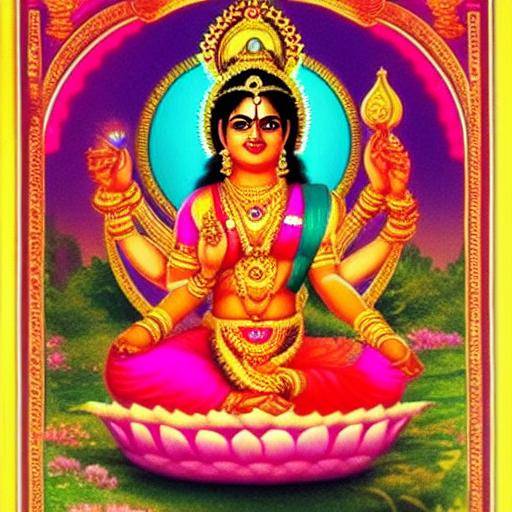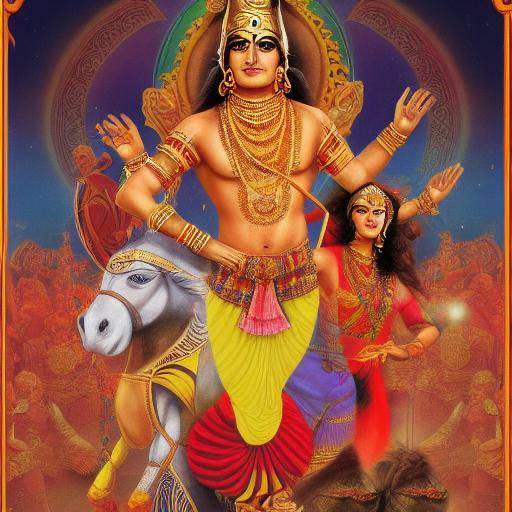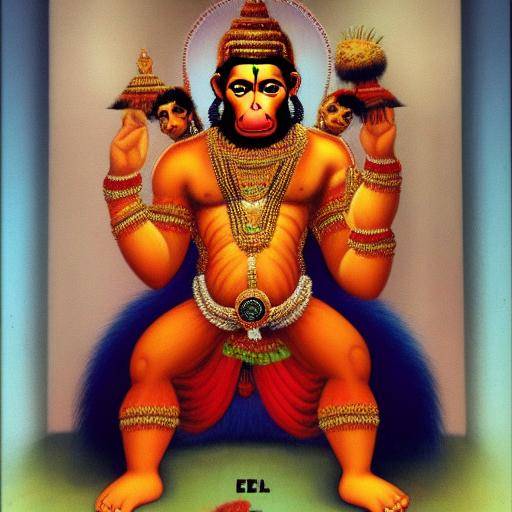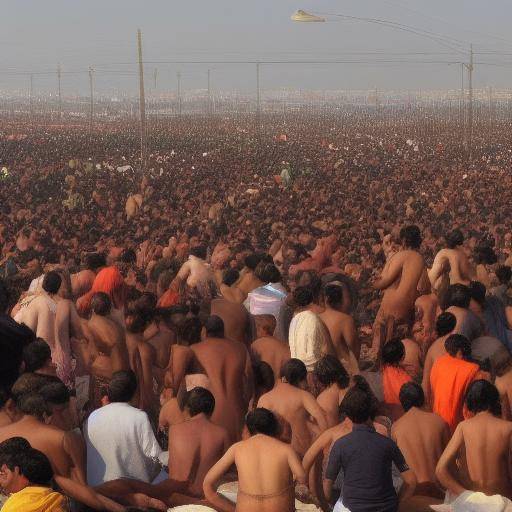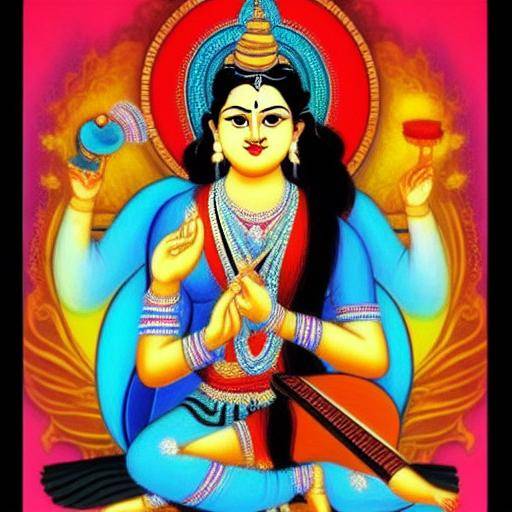
Introduction
Since time immemorial, Hindu mythology has fascinated cultures around the world with its narratives rich in symbolism and metaphysical meaning. Within this vast tapestry of myths and legends, the cosmic serpent Ananta emerges as a symbol of eternity and transcendence. In this article, we will explore in detail the figure of Ananta, its connection to the cosmic snake and its role in Hindu mythology. Throughout this immersion, we will unravel its origins, meaning and influence in different aspects of Hindu culture and spirituality. Let us prepare to be captivated by the infinity represented by Ananta.
History and Background
Ananta cosmic snake, also known as Shesha, is a fundamental deity in Hindu mythology. Its name itself, Ananta, means 'infinite' or 'without end', reflecting its role as a symbol of eternity in Hindu cosmology. It is believed that Ananta is the cosmic support on which Vishnu rests, one of the supreme gods in the Hindu pantheon, and is described as a multi-headed serpent holding the worlds on his back. This visual representation of Ananta as a serpent of countless heads and spiraling spirals symbolizes the infinity of time and the universe in the Hindu worldview.
The origin of Ananta dates back to the ancient sacred scriptures of Hinduism, like the Puranas, where it is described as a primordial being that arose before the creation of the world. Its eternal nature and its role as the support of the universe give Ananta a fundamental importance in the Hindu worldview, relating it to concepts of stability, continuity and eternity. Throughout history, the figure of Ananta has been revered and celebrated in various sacred texts, rituals and artistic expressions, consolidating its presence as a lasting symbol in Hindu culture and spirituality.
Analysis in Deep
The importance of Ananta as a symbol of eternity extends beyond its mythological representation, finding resonance in various spheres of philosophy, art and religion. His presence is frequent in yoga and meditation, where he is associated with the notion of cyclical time and the search for transcendence. In popular culture, we have seen manifestations of Ananta's influence through tales, poetry and visual representations, showing its continued relevance in the collective imagination.
Similarly, the cosmic serpent as an archetype present in other cultures and traditions has also been the subject of deep interest and study. The presence of the serpent as a symbol of power, renewal and wisdom is found in ancient civilizations around the world, which invites us to reflect on the universal links that transcend geographical and temporal borders.
In the context of Hindu mythology, Ananta intertwines with concepts of karma, rebirth and the notion of cosmic interconnection, providing a metaphysical framework to understand the very nature of existence. This profound perspective has fed the practice of introspection and self-knowledge, inspiring countless spiritual seekers to explore the meaning of their existence in the light of eternity represented by Ananta.
Comprehensive review
By understanding the influence of Ananta as a symbol of eternity, it is essential to consider its impact on contemporary spirituality and its relevance in an increasingly interconnected world. Ananta's legacy reminds us of the importance of recognizing the magnitude of time and continuity in our lives, motivating us to adopt a perspective that transcends the ephemeral and transient. In addition, it invites us to reflect on the need to preserve balance and harmony in our interactions with the world around us, recognizing that we are part of an infinite network of interconnected relationships.
Beyond its spiritual significance, the cosmic serpent Ananta also offers us valuable lessons in terms of resistance, constancy and stability in times of change and transformation. The metaphor of Ananta holding the worlds with its infinity winding can be interpreted as an eternal reminder of the importance of keeping our inner strength and resilience to the vicissitudes of life.
Comparative analysis
By exploring the figure of Ananta as a symbol of eternity and its relation to the notion of the cosmic serpent, it is intriguing to observe the connections and contrasts with other representations of the serpent in different cultural and mythological contexts. The serpent, as a polyphacetic symbol, has captured human imagination throughout history, appearing in mythologies of various civilizations with meanings ranging from fertility and wisdom to betrayal and danger.
In Greek mythology, the figure of the serpent is associated with the healing deity Asclepio, whose symbol, the stall with a snarled serpent, reflects aspects of healing and rebirth. On the other hand, in the Nordic mythology, the Jormungandr snake represents chaos and threat, personifying the struggle between order and disorder.
The comparison of these representations with the cosmic serpent Ananta invites us to reflect on the nuances and universality of symbols through different cultures, as well as to appreciate the diversity of meanings that can be attributed to the same archetype depending on the context in which it is found.
Practical Tips and Accessible Recommendations
For those interested in further exploring the symbolism of Ananta and its relevance in Hindu mythology, it is recommended to familiarize themselves with the Hindu sacred texts, such as the Puranas, and to seek the guidance of scholars and spiritual teachers who can give a deeper perspective on this ancestral figure. The practice of yoga and meditation can also offer a personal experience of connection with the symbolic aspects of Ananta, allowing a deeper insight into its meaning in everyday life.
Conclusions and FAQs
In conclusion, the cosmic serpent Ananta endures as a timeless symbol of eternity in Hindu mythology, resonating with the human quest for transcendence and continuity. His presence in multiple dimensions of Hindu culture and spirituality offers countless points of reflection and contemplation, reminding us of the importance of recognizing infinity in the midst of finiteness and of seeking stability in a constantly changing world.
Frequently asked questions
What is the importance of the cosmic serpent Ananta in Hindu mythology?
Ananta is revered as a fundamental symbol of eternity and stability in Hindu mythology, serving as a reminder of the continuity of time and the universe.
How does Ananta figure relate to contemporary Hindu spirituality?
In contemporary spirituality, Ananta is regarded as a symbol of transcendence and continuity, inspiring practices such as yoga and meditation.
What lessons can we learn from Ananta's symbolism in our daily lives?
Ananta's symbolism invites us to reflect on the importance of maintaining inner stability and resistance to the challenges of life, as well as recognizing the interconnection of all things.
How is the representation of the cosmic serpent Ananta compared to other figures of snakes in different mythologies?
The symbolism of the cosmic serpent Ananta is distinguished by its association with eternity and continuity, in contrast to other representations of snakes that encompass a diverse range of meanings, from healing and fertility to chaos and betrayal.
How can I deepen my understanding of Ananta's symbolism?
To gain a deeper understanding of Ananta's symbolism, it is recommended to explore Hindu sacred texts, seek guidance from scholars and spiritual teachers, and consider yoga practice and meditation as means of personal connection with this archetype.
Is there any holiday or ritual dedicated to Ananta in the Hindu tradition?
Yes, in Hindu tradition, there is a festival known as "Anant Chaturdashi", which is celebrated in honor of Ananta. During this festival, rituals and practices are performed that honor eternity symbolized by Ananta.
How has Ananta's symbolism influenced artistic and cultural expressions?
Ananta's symbolism has permeated the artistic and cultural expression in India and beyond, inspiring numerous visual representations, poetry and narratives that reflect its meaning as a lasting symbol of eternity and continuity.
What lessons can we draw from Ananta's symbolism in a contemporary context?
In the contemporary world, Ananta's symbolism offers valuable lessons on the importance of recognizing continuity in the midst of change, the connection between all beings and the need to maintain inner stability in times of uncertainty.
How does Ananta's figure relate to spiritual practices and the philosophy of Hinduism?
Ananta is intertwined with the spiritual practices and philosophy of Hinduism by offering a symbolic representation of eternity, continuity and cosmic connection, which are fundamental in the understanding of existence and spiritual search in this tradition.
With this, we trust that this exploration of the cosmic serpent Ananta has been enriching and enlightening. His symbolism endures as a bright lighthouse that guides the understanding of eternity and transcendence in the rich upholstery of Hindu mythology.

